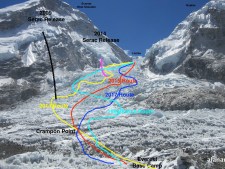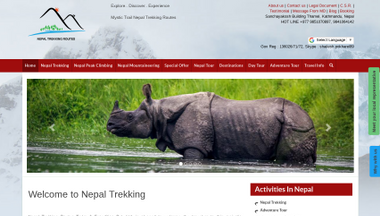
Right on time, climbers and trekkers from around the world are arriving in Kathmandu. Some have already flown to Lukla to begin their trek to Everest Base Camp.
I say this every year – if you ever get the chance to trek in Nepal, or the Khumbu especially, jump on the chance. I promise you it will change your life. My first visit was in 1997 for a trek to Everest Base Camp (EBC) via the Goyko Lakes. I was captivated by the people of Nepal, the Sherpa culture, the villages, teahouses, monasteries, monks, yaks, the pizza 🙂 … well you see what I mean. I returned home with new sense of the world and how we might possibly could get along. Thankfully I have returned to Nepal 13 times since then.
International Mount Guides, aka IMG, has checked in from Kathmandu with their usual large team. Between their Sherpa lead team and the Western guided team, I expect IMG to have over 30 clients. They usually have the largest team but recently, Seven Summits Treks who has been aggressive with offering low cost climbs (as low as $20K compared to IMG’s $45K) has easily hosted over 60, or even 100 clients in a single season.
IMG will acclimatize on Lobuche East at 6,119 m (20,075 ft) to eliminate one rotation through the Icefall. They still have their members sleep at Camps 1, 2 and 3 with at least two rotations before going for the summit. Himalayan Experience aka Himex does something similar.
Another variation on acclimatizing before climbs is shown by Tim Mosedale who takes his climbers on a three-week trek instead of arriving at EBC then going through the Icefall or using Lobuche. Still, Tim has his climbers do a couple of rotations.
Guy Cotter of Adventure Consultants is guiding one private client who is said to be attempting Everest, Lhotse and Nuptse this season. While this has been done, it is quite rare. Kenton Cool was the last to get all three in a single season in 2013.
The teams climbing from the Tibet side usually arrive in Kathmandu, or Lhasa, in early April. Since they drive to base camp, it is shorter but they still spend a few nights along the way for acclimatization.
EverestER is already up and running. This valuable medical service is staffed by volunteers and offers medical services for foreigners for $100 for the season. All Sherpas, porters and locals are treated free of charge. They posted last week that they have already treated 50 patients and had one helicopter evacuation for HAPE.
Expect Another Big Year and Deaths
In 2017 there were 648 summits, 237 from Tibet and 411 from Nepal including 11 climbers who didn’t use supplemental oxygen. There were 6 deaths. I expect about the same number on both sides this year. Some climbers will be using their 2014 permits. Nepal extended those for five years to 2019 after a Sherpa strike closed that side of the mountain. But the 2015 permits that were extended for two years after the earthquake closed Everest have now expired. Expiring permits were one factor in the 2017 season with 166 people using permit extensions.
If the weather holds, there could be over 200 summits from the Tibet side and over 400 from the Nepal side. Sadly I believe 6 to 8 people will die on Everest this spring, mostly on the Nepal side from inexperienced climbers climbing with unqualified guides. This has been the pattern the past few years. Also, I expect to see record frostbite and helicopter “rescues” since the helicopter services are now controlled by Nepali guide companies and they make a significant profit from the insurance coverage of climbers and trekkers.
Filed under: Alan Arnette, all eight-thousanders, Climbers, Everest, Expedition, Himalayas, mountaineering, Nepal, Routes, Tibet, Travel | Tagged: Adventure Consultants, Everest Base Camp, International Mount Guides, Northeast Ridge, Seven Summits Treks, Southeast Ridge | Leave a comment »


































